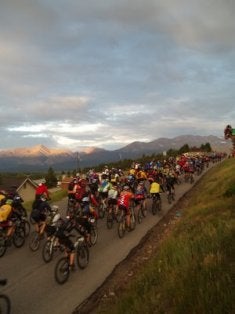Smart Nutrition for the Trail

This past weekend was the Leadville Trail 100-mile bike race—some guy named Lance Armstrong came in second, pushing six-time winner Dave Wiens to a course record and recording the second fastest time ever. Armstrong’s coach, Chris Carmichael was also there, for the third time, and finally broke the 9-hour barrier, finishing 20-minutes ahead of his time last year. It was a great event for everyone, but what I found interesting was something I saw several days beforehand: Carmichael sitting down with his staff dietitian Alicia Kendig to map out a nutrition strategy for the entire race. They discussed when and how many energy gels he was going to eat, how many bottles of water he’d drink vs. bottles of sports drink, and they even figured out when he should eat some solid food so he wouldn’t get sick of energy gels over 9 hours.
Why the obsession? Because Carmichael understood that how much energy he had during the last 25 miles of the race was going to be determined by how many calories he’d consumed in the first 50 miles. The body can only digest roughly 160 calories per hour and depending on how fit you are, the body has around 90 minutes of juice stored in its muscles. In a bike race like Leadville, it’s easy to burn through the equivalent of a Big Mac and fries every hour, anywhere from 600-800 calories. Do the math, and you’ll see that eventually you’re going to run out of gas no matter how many calories you’re drinking or eating. The body can’t keep up. The key, therefore, is to push back that point where you start tapping the energy supplied by your muscles as far as possible by eating early and often.
On a full-day hike or mountain climb, the same approach works equally well. Eat a big breakfast and then keep eating handfuls of gorp or a sports drink throughout your time on the trail. This way you should arrive at your halfway point or summit feeling full and adequately powered for the trip home. Everyone knows that most injuries and accidents on mountains occur on the way down mountains, and I’d bet the majority of these problems happen because people are running on fumes by that point. If they stopped on the way down, they’d probably polish off 16 ounces of steak and a vat of mashed potatoes (even the vegetarians). That’s their bodies telling them that they’re bonking and overcooked.
I realize that going for a climb is a much different aerobic endeavor than a bike race, and the last thing anyone really wants to associate with nature is a scientific approach to energy management, but let’s get real, no one enjoys stumbling back to the trailhead on the verge of collapse, sniping at spouses and friends, and seriously wondering if they’re going to have enough of their wits to drive home. Next time you head out on a 2+ hour hike, kick off your first step with a banana or some fruit, then make sure to eat something every 40 minutes or so. See how you feel when you’re done. If your legs are tired, but your brain feels sharp, you did it right.